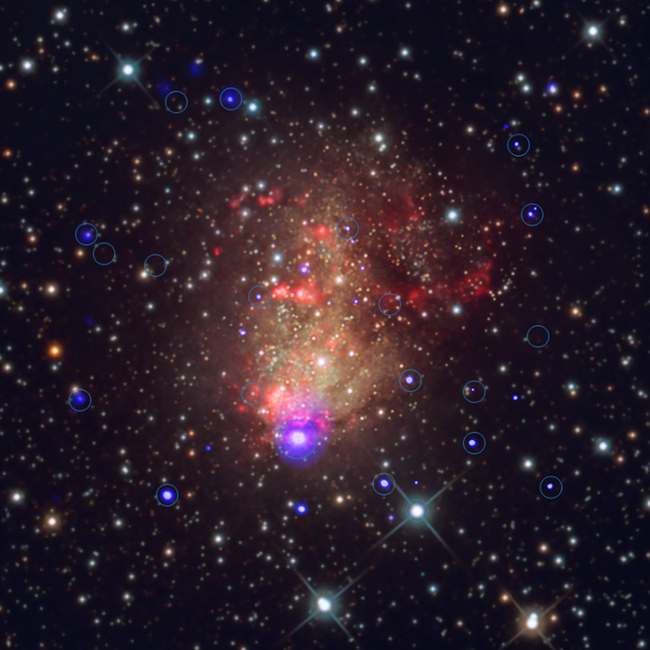
Starbursts and Time Bombs
 Credit: X-ray: NASA/CXC/UMass Lowell/S.Laycock et al. Optical: Bill Snyder Astrophotography
Credit: X-ray: NASA/CXC/UMass Lowell/S.Laycock et al. Optical: Bill Snyder Astrophotography
Star formation can occur as a relatively slow peaceful process, but some environments experience unusual, rapid bursts of star formation, perhaps driven by collisions between galaxies. Studies of groups of luminous, rare, massive stars formed in these starbursts
help us understand how star formation really works in a variety of cosmic settings. That's because massive stars evolve
so quickly they serve as signposts of recent, active star formation. Because massive stars are so luminous, they can be identified and studied out to large distances. The small galaxy called IC 10
serves as a interesting testbed of theories of star formation. IC 10, though a small galaxy, hosts a surprisingly large number of massive stars, indicating that star formation has been particularly active. The stellar population of IC 10 includes both unevolved and evolved massive stars. The most massive of these evolved massive stars have suffered extreme evolution, exploding as supernovae
and leaving behind compact neutron stars or black holes
in their wake. Determining the number of these compact objects in IC 10 relative to the number of massive stars helps us understand the overall demographics of massive star formation. These compact objects can best be identified using X-ray observations. A new study of IC 10 using high spatial resolution images from the Chandra X-ray Observatory
obtained from 2003 to 2010 provides the best exploration of the X-ray source population in IC 10. The image above is a composite optical image (in red, green, blue) combined with a Chandra image of the X-ray emission (in darker blue). Overall, Chandra detected 110 sources of X-rays in IC 10. Sixteen of these sources have been identified as massive X-ray binaries, in which the massive star has an neutron star or black hole companion which swallows material from the massive star, producing bright, variable X-ray emission in the process. The relatively large number of X-ray binaries helps constrain the age of the starburst, and provides important insights into how starburst activity occurs in relatively low mass galaxies like IC 10.
Published: August 28, 2017
<
HEA Dictionary ● Archive
● Search HEAPOW
● Other Languages
● HEAPOW on Facebook
● Download all Images
● Education ● HEAD
>

Each week the HEASARC
brings you new, exciting and beautiful images from X-ray and Gamma ray
astronomy. Check back each week and be sure to check out the HEAPOW archive!
Page Author: Dr. Michael F. Corcoran
Last modified Tuesday, 27-Feb-2024 10:06:42 EST


